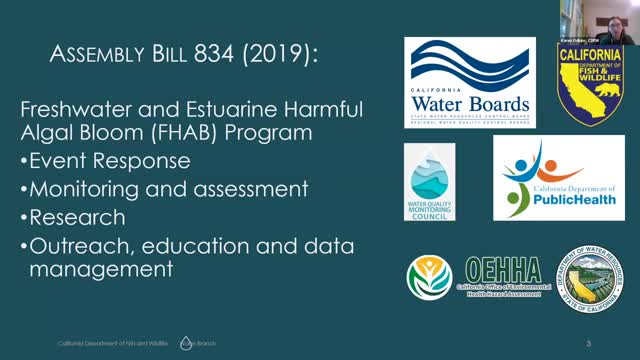California battles harmful algae blooms to protect public health
December 05, 2024 | California Water Quality Monitoring Council, Boards and Commissions, Executive, California
Thanks to Scribe from Workplace AI and Family Portal , all articles about California are free for you to enjoy throughout 2025!

This article was created by AI using a video recording of the meeting. It summarizes the key points discussed, but for full details and context, please refer to the video of the full meeting. Link to Full Meeting
The meeting highlighted the multifaceted approach taken by the council, which includes immediate incident response, long-term monitoring, applied research, and public outreach. A key focus was the investigation of illnesses linked to HABs, which can affect not only humans but also wildlife and domestic animals. The council emphasized the importance of timely reporting and thorough investigation to prevent future cases of illness related to algal blooms.
One of the critical components discussed was the process of triaging reports of potential HAB-related illnesses. Information is collected from various sources, including web forms and Poison Control, and is entered into a database for further analysis. This systematic approach ensures that cases are thoroughly investigated, with findings shared with the Centers for Disease Control and Prevention (CDC) to enhance understanding and prevention strategies.
The council also addressed the complexities involved in determining whether an illness is HAB-related. Cases are categorized based on the evidence available, ranging from \"suspect\" to \"confirmed.\" This classification system is crucial, especially when dealing with wildlife, as many factors can complicate the assessment of exposure and illness.
As the meeting progressed, officials shared data on incident reports and illnesses associated with HABs. Preliminary figures for 2024 indicated a concerning trend, with an increase in reports of algal blooms and related health issues. The council noted that while the number of reports has risen, only a fraction of these cases have been confirmed as HAB-related, underscoring the need for continued vigilance and research.
In conclusion, the discussions at the California Water Quality Monitoring Council's meeting underscored the collaborative efforts required to tackle the challenges posed by harmful algal blooms. With ongoing monitoring, research, and public education, officials are hopeful that they can mitigate the risks associated with these environmental hazards and protect both public health and aquatic ecosystems. As the council prepares for future meetings, the commitment to addressing these critical issues remains steadfast, ensuring that California's waters are safe for all.
Converted from Fall 2024 CCHAB Network Meeting - November 20, 2024 meeting on December 05, 2024
Link to Full Meeting
Comments
View full meeting
This article is based on a recent meeting—watch the full video and explore the complete transcript for deeper insights into the discussion.
View full meeting